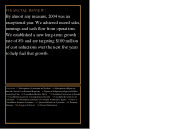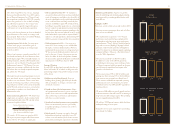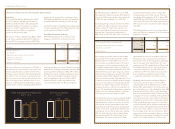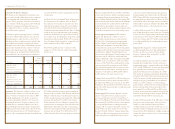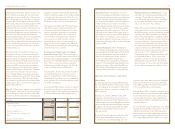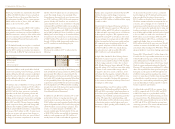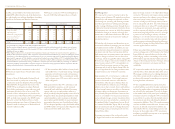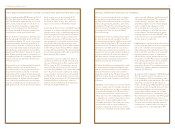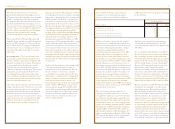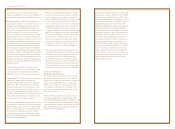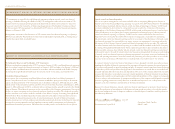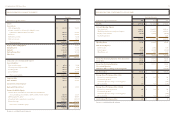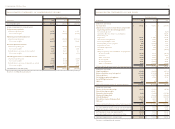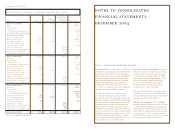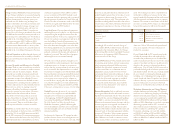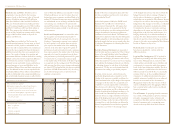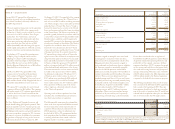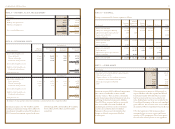North Face 2004 Annual Report Download - page 35
Download and view the complete annual report
Please find page 35 of the 2004 North Face annual report below. You can navigate through the pages in the report by either clicking on the pages listed below, or by using the keyword search tool below to find specific information within the annual report.
65vf corporation 2004 Annual Report
This Statement also requires us to reevaluate
goodwill and indefinite-lived intangible assets in
all business units at least annually or more frequently
if there is an indication of possible impairment.
For 2004 and 2003, the indicated fair value of the
goodwill and indefinite-lived intangible assets in
the respective business units exceeded the carrying
amount of those assets. In 2002, we determined
that $2.3 million of goodwill in our VF Playwear
business unit was impaired and, accordingly,
recorded an impairment charge for that amount.
We recorded Property, Plant and Equipment and
Intangible Assets acquired in our 2004 Acquisitions
and in our 2003 acquisition of Nautica at the fair
value of those assets. We engage an independent
valuation firm to assist us in assigning fair values to
our acquired Intangible Assets and, as necessary,
other assets.
•Pension obligations – VF sponsors defined benefit
pension plans as a key retirement benefit for most
domestic employees. Since pension obligations will
ultimately be settled far in the future, determination
of accumulated and projected pension benefit
liabilities and of our annual pension expense is
subject to assumptions and estimation. The principal
assumptions are summarized in Note N to the
Consolidated Financial Statements. We review
these assumptions annually and modify them based
on current rates and trends. Actual results may vary
from the actuarial assumptions used.
One of the critical assumptions used in the actuarial
model is the discount rate. The discount rate is used
to estimate the present value of our accumulated
and projected benefit obligations at each valuation
date. We evaluate our discount rate assumption
each year and adjust it as necessary based on current
market interest rates. For our September 30, 2004
valuation, we decided, in consultation with our
independent actuary, to refine our approach for
selecting a discount rate. We changed to a method
of estimating our discount rate based on matching
high quality corporate bond yields to the expected
benefit payments and duration of obligations for
participants in our pension plans. Previously, we
had estimated our discount rate by reference to the
Moody’s Aa bond index. This change was prompted
by a significant change in the composition of bonds
in the Moody’s Aa bond index during 2004,
resulting in (1) a yield for the revised index differing
significantly from other high quality bond indices
and (2) the index becoming less reflective of our
expected pension payments. We believe our 2004
discount rate of 6.10% appropriately reflects current
market conditions and the long-term nature of
projected benefit payments to participants of our
pension plans. Further, the discount rate for our
plans may be higher than rates used for plans at
some other companies because of our plans’ higher
percentage of females with a longer life expectancy
and higher percentage of inactive participants with
vested benefits who will not begin receiving benefits
for many years.
Another critical assumption of the actuarial model
is the expected long-term rate of return on
investment assets in our pension trust. Because
the rate of return is a long-term assumption,
it generally does not change each year. This rate,
determined in consultation with our independent
actuary, is based on several factors, including the
plan’s mix of investment assets, historic and
projected market returns on those assets and current
market conditions. We had been using an 8.75%
return assumption during 2003 and 2002, which
was less than our actual compounded annual return
over the preceding 15 years. Based on a current
evaluation of the factors mentioned above, our
investment return assumption was reduced to
8.50% for 2004 and 2005.
The sensitivity of changes in these valuation
assumptions on our annual pension expense
and on our plans’ projected benefit obligations
(“PBO”), all other factors being equal, is illustrated
by the following:
Increase (Decrease) in
Dollars in millions Pension Expense PBO
0.50% decrease in discount rate $14$78
0.50% increase in discount rate (13) (73)
0.50% decrease in expected investment return 4
0.50% increase in expected investment return (4)
Differences between actual results and actuarial
assumptions are accumulated and amortized over
future periods. During the last several years, actual
results have differed significantly from actuarial
assumptions, resulting in $267.7 million of
accumulated net unrecognized losses at our 2004
valuation date. These accumulated losses arose
because (1) our pension plan liabilities increased
substantially as a result of the overall decline in the
discount rate from 8.00% in 2000 to 6.10% in 2004
and (2) although our actual investment return on
pension plan assets exceeded the actuarially assumed
rate in 2003 and 2004, significant investment losses
were incurred in 2002 and 2001 due to the overall
decline in the securities markets. Our policy is to
amortize these unrecognized gains and losses to
pension expense, as follows: amounts totaling less
than 10% of the lower of investment assets or PBO
at the beginning of the year are not amortized;
amounts totaling 10% to 20% of PBO are amortized
over 10 years; and amounts in excess of 20% of PBO
are amortized over five years.
The cost of pension benefits earned by our
employees (commonly called “service cost”) has
averaged $19.7 million per year over the last three
years. However, pension expense recognized in our
financial statements has significantly exceeded the
average annual service cost. Our recorded pension
expense for continuing operations was $57.8 million
(including a $7.1 million partial plan curtailment
charge) in 2004, compared with $55.7 million in
2003 and $26.2 million in 2002 (including a $2.4
million curtailment charge). Both the 2004 and the
2003 expense were higher than the average annual
service cost because those years included a
significant cost component for amortization of
accumulated net unrecognized losses. For 2005,
our pension expense is expected to be approximately
$44 million.
Our accumulated benefit obligations exceeded the
fair value of plan assets at our most recent valuation
date. Accordingly, we have recorded a minimum
pension liability of $157.0 million (net of a prepaid
pension asset). The amount of the liability, along
with the related charge to Common Stockholders’
Equity, could change significantly in future years
depending on securities market fluctuations
affecting actual earnings of the pension plan assets,
interest rates and the level of VF contributions to
the plan. To improve the funded status of the plan,
we have increased our level of contributions to the
plan, with cash contributions of $55.0 million in
January 2005 and 2004 and $75.0 million in 2003.
Effective December 31, 2004, VF’s domestic defined
benefit plans were amended to close the existing
plans to new entrants. The amendments did not
affect the benefits of current plan participants or
their accrual of future benefits. Domestic employees
hired after that date, plus employees at recently
acquired businesses not covered by those plans,
will participate in a new defined contribution
arrangement with VF contributing amounts based
on a percentage of eligible compensation. Funds
contributed under this new arrangement will be
invested as directed by the participants. This new
defined contribution feature will not have an impact
on the 2005 expense for our defined benefit pension
plans. Over a period of years, however, the expense
of our defined benefit plans is expected to decline


